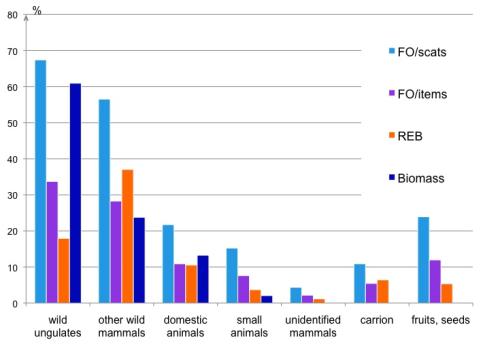A total of 46 wolf scats were collected from August 2010 to late January 2011


- Mammals constituted the bulk of the diet accounting for 73.9% of all occurrences ranging from 67.5% of the REB to 98,4% of the biomass ingested (see Fig. 11).
- The main food categories were the wild mammals (wild ungulates and medium sized mammals like mountain hares and beavers) representing 58.7% of the REB and 86.7% of the biomass eaten (see Fig. 11).
Mountain hare (occupying rank 1) followed by the moose (rank 2) and the wild boar (rank 3) were the three main prey eaten by wolves with some differences in rankings for the REB and the biomass methods. Indeed, moose represented 45% of the biomass ingested (16.6 kg) the wild boar accounted for 16% (5.7 kg) and the mountain hare constituted 14% (5.2 kg) of it (see Fig. 9).
- Domestic animals were of secondary importance accounting for 10.5 % of the REB and 13.3% of the biomass, occurring 10 times of 46 scats (21.7%) (see Fig. 11). Sheep was the main domestic animal prey representing 12.2% of the biomass ingested and occupying the third rank with REB method (8.7%) (see Fig. 9).
- Fruit and seeds frequently occurred in the scats (11 times in 46 scats: 24% of the cases) and also in comparison with other food items (12%) (see Fig. 11). The graminae and other plant items (leaves, wood, Picea abies needles, Sphagnum, Equisetum) appeared very frequently (41% of the total food items) and represented 17% of the REB.
- Carrion category regrouped mainly the carrion given as food supplement during the winter and were typically distinguished by the presence of cattle bones in the scat without any hair and the scat itself was of a particular consistence. Five scats out of 46 scats were constituted of carrion (11% of occurrences per scats but 5.4% of occurrences per items), which represented about 6.4% of the REB (see Fig. 11).
- Some mammal remains recovered in scats (two times out of 46 scats) could not be identified and were categorized as non-identified mammals.
- The released wolves were seen several times preying on microtinae in open field. This food type, including Microtus sp. and Sorex sp. essentially, represented 6.5% of the occurrences per scat but 1.5% of the biomass ingested (see Fig. 9). They occasionally ate birds such as passerines (three times out of 46 scats) but generally small animals (i.e. microtinae, birds, insects) represented quite a small part of their diet (3.7% of the REB and 2% of the biomass consumed) (see Fig. 11).
- Some other items (stones, papers, strings) were occasionally found in wolf scats (0.07% of the REB).
Statistical tests for comparisions between methods
- Agreement among rankings was significant in all simultaneous and pairwise comparisons (0.76 ≤ W ≤ 1.0 and 0.90 ≤ rs ≤ 1.0, p < 0.01): it was particularly strong for the most important food items (i.e. rank ≤ 3), although some variations exist.
Responsible for this page:
Director of undergraduate studies Biology
Last updated:
05/01/11
